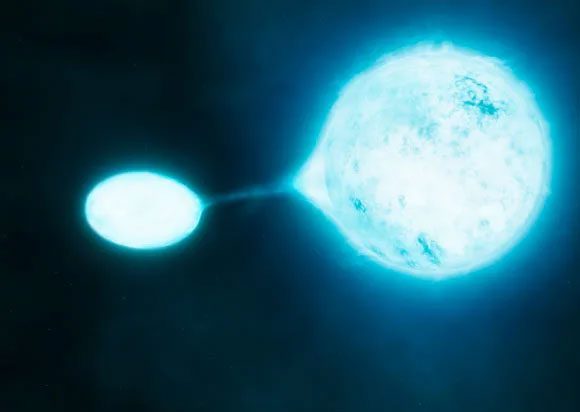A colossal object predicted to collide with the galaxy containing Earth in 2 billion years has revealed traces of a terrifying “vampire” star population.
According to Sci-News, scientists have recently discovered mysterious helium star populations, bare in the Large Magellanic Cloud and Small Magellanic Cloud, which are two satellite galaxies of the Milky Way.
These stars, large and fearsome, are actually victims of cosmic “vampires.”

Small vampire star may be a neutron star – (Photo: ESO).
The research team led by Dr. Maria Drout from the University of Toronto (Canada) selected 25 helium stars among them for study. Most of these stars were found to have a companion “vampire” star.
Vampire stars are typically dead stars such as white dwarfs or neutron stars, which possess powerful energy despite their small size, continuously siphoning material from a larger companion, usually a red giant star nearing death rather than a helium star.
These stars often have a hydrogen-rich outer shell. It has long been hypothesized that a form of star could exist that is stripped down, creating an aggressive new type of star with a surface saturated with hot helium, having a mass 2-8 times that of the Sun.
Their companions are likely to be neutron stars or black holes rather than white dwarfs.
Neutron stars are also remnants like white dwarfs, but they are the remnants of massive stars.
After a time of being drained, the authors suggest that these hydrogen-depleted stars will explode as hydrogen-poor supernovae, while the remnants collapse into a new neutron star.
This process may set the stage for neutron star mergers or mergers between neutron stars and black holes, which are among the most energetic events in the universe.
Regardless of the outcome, it is clear that Earth is on a path toward a more fascinating world than we ever thought.
One of these two galaxies containing “vampires” is the Large Magellanic Cloud, which is predicted to collide with the Milky Way galaxy in 2 billion years.
This satellite galaxy will not be sufficient to devastate the Milky Way, which is a significantly larger galaxy. Rather, it will be consumed by the Milky Way.
However, the collision is believed to potentially knock Earth out of the habitable zone of the solar system.


















































